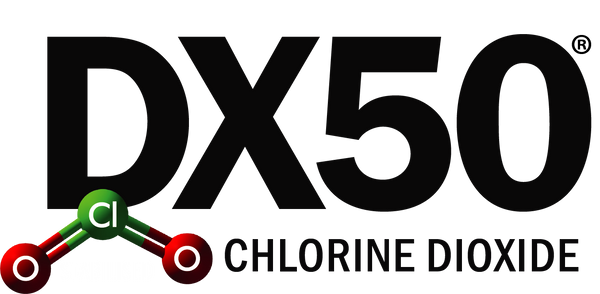What is Chlorine Dioxide?
Chlorine Dioxide (ClO2) is relied on by multiple industries around the world and in many everyday products to kill germs quickly, effectively, and safely. It is an extremely powerful sanitiser and antimicrobial that has been used for the past century to make public water safe to drink and to help prevent the spread of bacterial infections and disease.
Unlike other sanitisers, ClO2 is especially effective at killing tough germs that have developed a resistance to chlorine. It works by oxidation - reacting to the acid in the cell walls of microorganisms which kills them quickly.
This oxidising process is so powerful that ClO2 has the broadest efficacy against microbial organisms that include bacteria, viruses, protozoa, yeasts, fungi, mycobacteria, and bacterial spores.
Here's how DX50 stabilised Chlorine Dioxide works
Chlorine dioxide acts as an oxidising agent, but it works differently to other oxidisers like chlorine because of its unique chemical behaviour.
It penetrates the cell wall by stealing electrons from the microorganism’s vital structures (cell walls, membranes, organelles, and genetic materials) and reacts with the amino acids in the cytoplasm within the cell. This disrupts the protein function and enzyme action and kills the microorganism.
At low concentrations, ClO2 kills microorganisms even when they are inactive, and because they die so fast the pathogens cannot become resistant. Chlorine dioxide even kills Giardia Lambia and Cryptosporidium, which are highly resistant to other disinfectants including sodium hypochlorite and chlorine.
Importantly, chlorine dioxide is a size selective antimicrobial agent that can rapidly kill microorganisms, but not larger humans and animals. This selectivity isn’t based on the different biochemistry between microbes and humans, but on the difference in size.
A flexible alternative
DX50 Water Treatment is not pH dependent and works most effectively in cold water. DX50 can also break down the protective biofilm surrounding a wide range of pathogens.
| Chemical
|
DX50® Chlorine Dioxide |
Chlorine - Sodium Hypochlorite |
| Killing Power |
High (2.46) |
Moderate (1.00) |
| Microbial Range |
Broad Spectrum: Effective against all Bacteria, E-coli, Virus, mould, Fungi, Algae, and spore formers |
Less effective against fungi & spore formers. Ineffective against viruses |
| Dose (parts per million) |
50 ppm |
600ppm |
| Killing Speed |
Minutes |
Minutes - Hours |
| Corrosivity |
Negligible at use concentration |
High to most metals |
| Optimal Kill Conditions |
2 - 11 pH |
6.8 - 7.3 pH |
How was chlorine dioxide discovered?
Chlorine dioxide is a neutral chemical compound that consists of one chlorine atom and two oxygen atoms. It is a yellowish-green gas that at normal room temperature (above 11oC) is highly soluble, but it doesn’t react with water.
It was discovered in 1814 by British chemist Sir Humphrey Davy when he dropped sulfuric acid (an acidic reactor) on to potassium chlorate (the precursor to chlorine dioxide).
At temperatures between 11oC and −59oC the gas turns into a reddish-brown liquid and below −59oC it becomes bright orange crystals. Later experimentation replaced the sulfuric acid with hypochlorous acid to produce chlorine dioxide. As a gas ClO2 is unstable and potentially dangerous if inhaled, so it is normally generated in water solution by using sodium chlorite.
By 1939, sodium chlorite became established as a commercial product for the generation of ClO2. With powerful oxidising, antimicrobial, and bleaching properties interest in ClO2 grew rapidly. Its use spread widely for treating municipal drinking water supplies.
What is chlorine dioxide used for?
In recent years the use of ClO2 has extended considerably for a variety of liquid, gas, and surface treatment applications. This includes disinfecting food processing and equipment, medical and pharmaceutical equipment, agriculture and horticultural environments, premises and vehicles, bio-medical waste, wastewater, mould eradication, microbiological control in cooling towers, air disinfection and odour control, treatment of swimming pools, dental applications, wound cleansing, and more.
The compound is favoured over other disinfectants for treating water because ClO2 is also more effective at reducing unpleasant odours, tastes, and colours, and for removing mould and algae. Plus, it helps to remove iron and manganese from untreated water.
Chlorine dioxide is also used in disaster management. It was used to decontaminate buildings after the 2001 anthrax attacks in the US, and to kill mould growing in flooded houses after Hurricane Katrina.
Nowadays, with increasing microbial resistance to traditional chemical disinfectants (such as alcohols and quaternary ammonium compounds), there is growing interest in ClO2 as a strong and effective biocide.
What’s the difference between chlorine and chlorine dioxide?
Many people confuse the term “chlorine dioxide” with a compound that acts like chlorine, which is misleading because chlorine is not in fact the active element.
Chlorine has two chlorine atoms and no oxygen (Cl₂) and works by chlorinating, whereas ClO2 has one chlorine and two oxygen atoms and works by oxidising.
While they’re both oxidisers (electron receivers), ClO2 is very different from elemental chlorine both in its chemical structure and in its behaviour. Firstly, chlorine dioxide doesn’t react (or reacts extremely slowly) with most organic compounds of a living tissue because it is size selective. What this means is it can kill micron-sized organisms fast, but it can’t do much harm to larger organisms like animals or humans, as it is unable to penetrate deeply into their living tissues.
Secondly, ClO2 has more than 2.5 times the oxidation capacity of chlorine, and it kills bacteria, viruses, and protozoa differently via an electron exchange. It can take in five electrons before it is reduced and forms a stable chloride, whereas chlorine can only absorb two electrons.
The organic material selectivity and greater oxidation capacity of ClO2 makes it a stronger oxidative disinfectant than chlorine.
What about residues?
The electron exchange difference also explains why ClO2 does not form chlorinated compounds when it reacts with organic substances.
When exposed to organic matter and sunlight, ClO2 breaks down quickly and leaves minimal to no detectable chemical residues. The only by-products of chlorine dioxide’s oxidising reaction are chlorite and chloride, which at low levels is harmless to humans and animals.
Whereas when chlorine reacts, it not only accepts electrons, it also takes part in addition and substitution reactions; adding one or more chlorine atoms to the substance to form environmentally dangerous chlorinated organics, including potentially carcinogenic residues and trihalomethanes such as chloroform.
As the diagram below shows, while dosing the same concentrations, in heavily polluted water the residual concentration of ClO2 is much higher than the residual concentration of chlorine.
Therefore, disinfecting water with lower doses of ClO2 is not only more efficient and effective at killing bugs than chlorine, but safer for humans, animals, and the environment.
Is chlorine dioxide safe?
Chlorine dioxide rapidly decomposes after use and leaves no harmful by-products.
When applied in recommended doses, chlorine dioxide is safe and does not lead to health risks. The EPA’s maximum concentration for chlorine dioxide in public drinking water is 0.8 milligrams per litre (mg/L) and 1.0 mg/L for chlorite ion.
DX50 Water Treatment solution is known to be effective at an even lower ClO2 concentration of just 0.075 mg/L, which is well within acceptable limits. Applying just 50ml per 1000L of water will safely disinfect a full water tank in just a few hours.
In its concentrate form, however, chlorine dioxide is a hazardous gas and can cause irritation if inhaled. Because it is normally used in a diluted form, and quickly breaks down. Most of us are unlikely to breathe in dangerous levels of ClO2. Similarly, most people will not be exposed to ClO2 or chlorite in amounts large enough to damage the body.
When manufactured with dry ingredients, and at high ppm (parts per million), ClO2 is potentially explosive.
But ClO2 produced as a watery solution at around 4ºC becomes a nonhazardous gaseous diluent, as it does not hydrolyse to any appreciable extent. In this state it is quite stable, and will remain so for some time, but not indefinitely if exposed to air as ClO2 will slowly dissociate into chlorine and oxygen.
To maintain its stability, aqueous ClO2 solutions like DX50 should be stored in a cool, well-sealed and dark area protected from sunlight. It is best used within a year of manufacture.
Benefits of ClO2
- Approved by the Environmental Protection Agency as a primary drinking water disinfectant
- Five electrons produce higher oxidation capacity than chlorine
- It is highly soluble in water even in cold water - up to ten times more so than chlorine.
- Inactivates microorganisms over a broad pH range
- Superior germicidal properties
- Chlorine dioxide has the broadest efficacy against microbial organisms such as bacteria, viruses, protozoa, yeasts, fungi, mycobacteria, and bacterial spores
- Unlike other disinfectants, ClO2 is even effective against Cryptosporidium and Giardia
- Microorganisms cannot develop resistance to ClO2
- Can also be applied when a large amount of organic matter is present.
- Excellent residual disinfection action and biofilm control.
- Chlorite is the main disinfection by product of ClO2 which quickly reduces to form harmless chloride.
- Does not form chloramines and chlorogenic compounds as toxic by-products. Unlike ozone, chlorine dioxide does not oxidise bromide ions into bromate ions, which are known carcinogens. Nor does it produce large amounts of aldehydes and ketones.
- Chlorine dioxide improves water taste and odour
- It is more potent than equivalent doses of chlorine
- It destroys sulphides, cyanides, and phenols, controls algae, and neutralises iron and manganese ions
- Less chlorine dioxide is needed to obtain an active residual disinfectant than other disinfectants such as chlorine and ozone
- Less affected by nitrogenous wastes
| Oxidant |
Oxidation Strength |
Oxidation Capacity |
| Ozone (O3) |
2.07 |
2e−
|
| Hydrogen peroxide (H2O2) |
1.78 |
2e−
|
| Hypochlorous acid (HOCL) |
1.49 |
2e−
|
| Hypobromous acid (HOBr) |
1.33 |
2e−
|
| Chlorine dioxide (ClO2 ) |
0.95 |
5e−
|


